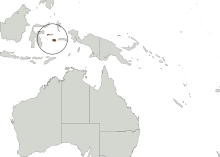Moluccan deer boar
| Moluccan deer boar | ||||||||||||
|---|---|---|---|---|---|---|---|---|---|---|---|---|

Moluccan deer boar skull |
||||||||||||
| Systematics | ||||||||||||
|
||||||||||||
| Scientific name | ||||||||||||
| Babyrousa babyrussa | ||||||||||||
| ( Linnaeus , 1758) |
The Moluccan deer boar ( Babyrousa babyrussa ) is a species of the deer boar (genus Babyrousa ) that occurs today only on the Indonesian Sula Islands Mangole and Taliabu and on the island of Buru . Historically, the range also included the island of Sulawesi , where this species is now extinct.
features
The different species of buck boar do not differ significantly in morphology. The animals reach a head and trunk length of 85 to 110 centimeters, a shoulder height of 65 to 80 centimeters and a tail length of 20 to 32 centimeters. They have a rounded body with relatively long and thin legs. The hairs of the Moluccan deer boar are comparatively long and dense, while the other two recent species are almost hairless. As a further difference, the coat of the Moluccan deer boar is gold-cream-colored or black, while the Sulawesi deer boar ( B. celebensis ) is rough and brown-gray and the Togian deer boar ( B. togeanensis ) is brown to black with a lighter belly side.
The most striking feature of the deer boars are the strongly developed tusks of the males. The upper canines do not grow into the oral cavity, but directly up through the muzzle , where they curve above the muzzle backwards towards the forehead. They reach a length of up to 30 centimeters. In females, these teeth are stunted or absent. The lower canines also grow out of the mouth and up past the side of the muzzle.
distribution and habitat
The Moluccan Hirscheber today exclusively on the Moluccas belonging Indonesian Sula Islands Mangole and taliabu and on the island of Buru common.
Historically, the range also included the island of Sulawesi , where this species is now extinct. It is assumed that the animals were introduced to the islands of today's range, although the actual historical range is unknown.
The buck boars live in tropical rainforest areas on the banks of rivers and ponds that are rich in aquatic plants.
Way of life
There is only a few specific information about the way of life of the Moluccan deer boar. It is believed that it differs little from the way of life of the Sulawesi deer boar.
Deer boars are omnivorous and feed on different parts of plants such as leaves, roots and fruits as well as animal food such as invertebrates (insects, worms) and small vertebrates. They are likely to be selective in their search for food, although unlike other pigs they are unlikely to dig as much in the ground as they lack the reinforcement of the nose by the rostral bone. Most likely they dig in loose sand and muddy ground. The animals on Sulawesi also visit areas with volcanic salt deposits, where they drink water and eat the soil. It can be assumed that this also occurs with Babyrousa babyrussa .
The Moluccan deer boar probably forms smaller groups that travel together. In the Sulawesi deer boar, older males were often observed alone, while the groups usually consist of a maximum of five animals, usually females with several young animals. However, troops of up to 13 animals were also observed at water points and other meeting points.
Systematics
The Moluccan deer boar is assigned to the genus of deer boar together with three other species .
These four species were originally considered as a single species and have been considered as separate species B. celebensis , B. togeanensis , B. babyrussa and B. bolabatuensis since 2001/2002 . It is unclear whether the animals from the islands of Sulawesi , Muna , Buton and Lembeh , which are currently assigned to the Sulawesi deer boar, are not more closely related to the Moluccan deer boar.
Threat and protection
The species is classified as endangered (vulnerable) by the International Union for Conservation of Nature and Natural Resources (IUCN) due to its population size. This classification is justified because of the very small distribution area, which is limited to the Sula Islands and Buru. In addition, the population has declined in recent years, mainly due to habitat loss due to logging and landscape changes as well as hunting by non-Muslim sections of the population. This trend is expected to continue.
The actual status of the populations is unknown, but it is assumed that the animals are largely undisturbed, especially in the remaining forests on Buru and Taliabu.
supporting documents
- ↑ a b c Ati Tislerics: Babyrousa babyrussa in the Animal Diversity Net. Retrieved May 20, 2012.
- ^ Meijaard, E., JP d'Huart, and WLR Oliver (2011). Babirusa (Babyrousa). Pp. 274-276 in: Wilson, DE, and RA Mittermeier , eds. (2011). Handbook of the Mammals of the World. Vol. 2, Hoofed Mammals. ISBN 978-84-96553-77-4
- ↑ a b c d e f g h Babyrousa babyrussa in the IUCN Red List of Threatened Species 2011.2. Posted by: AA Macdonald, J. Burton, K. Leus, 2008. Retrieved May 20, 2012.
- ↑ Don E. Wilson & DeeAnn M. Reeder (eds.): Babyrousa babyrussa ( Memento of the original from March 5, 2016 in the Internet Archive ) Info: The archive link was inserted automatically and has not yet been checked. Please check the original and archive link according to the instructions and then remove this notice. in Mammal Species of the World. A Taxonomic and Geographic Reference (3rd ed).
Web links
- Babyrousa babyrussa inthe IUCN Red List of Threatened Species 2011.2. Posted by: AA Macdonald, J. Burton, K. Leus, 2008. Retrieved May 20, 2012.
